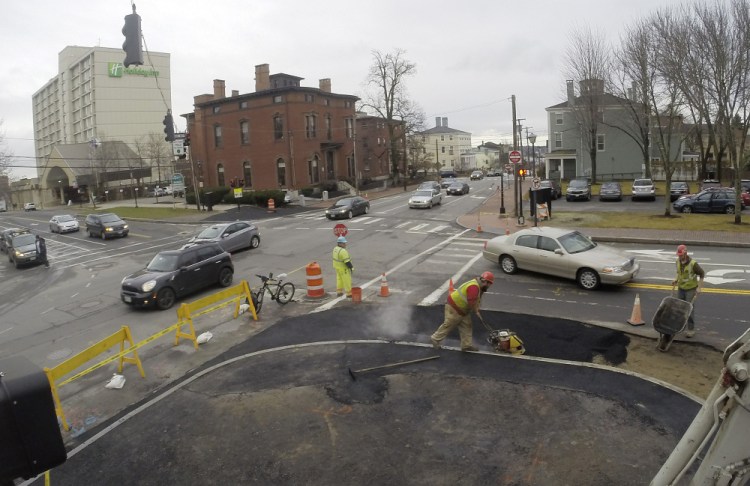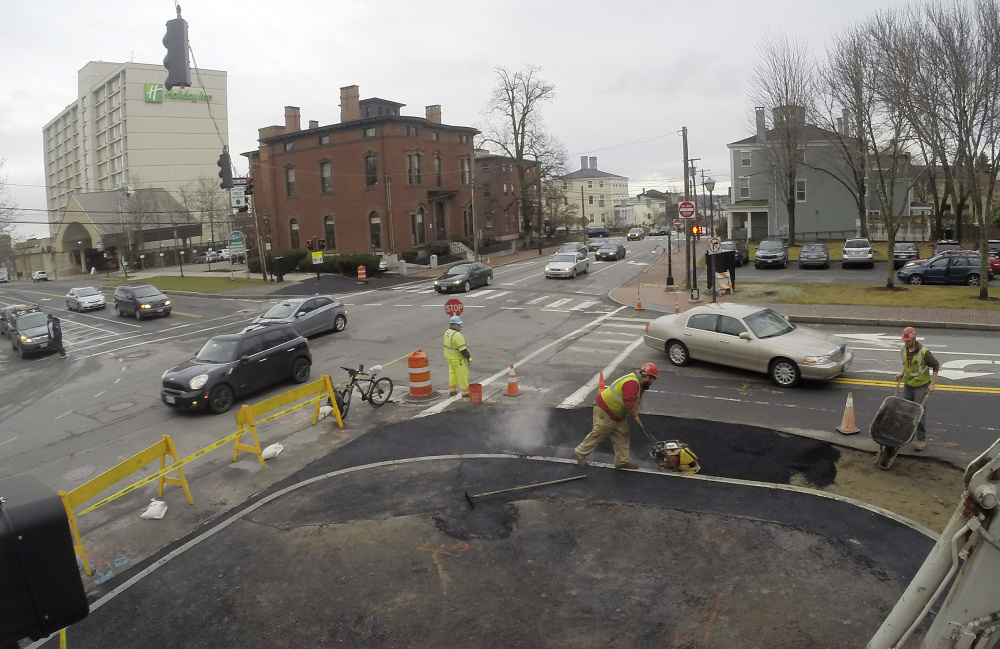Portland many not have dumped the bump at the corner of High and Spring streets, as residents requested, but the city is scaling back the curb extension to address safety concerns.
Crews on Friday were busy reducing the size of the extension – or bump-out – added on Spring Street in front of the Little Tap House, making room for an additional lane of traffic. Bump-outs are designed to improve pedestrian safety by decreasing the crossing distance and increasing visibility.
About 50 West End residents petitioned the city to “dump the bump,” saying it was dangerous because it protruded too far into the roadway and was difficult for drivers to see. One driver was filmed by a Press Herald photographer driving over the bump in broad daylight.
City Manager Jon Jennings said two weeks ago that he also was concerned about how the new bump-out would affect snow removal and promised to change the intersection after receiving approval from the Maine Department of Transportation.
Fixing the intersection is estimated to add $7,000 to $10,000 to the cost of the project, Jennings said.
“The city will make mistakes and I will take ownership of any that are made,” Jennings said on Friday. “It was important for me to make sure we fixed the situation at Spring and High. I am glad we were able to make the change so quickly.”
Mayor Ethan Strimling, who lives on Spring Street and received the petitions, called the smaller bump-out a “good compromise.”
“It improves safety while still making our city more walkable and bike friendly,” he said.
Some people remain skeptical that the project is a wise investment.
“I think they should get rid of it altogether. I think they’ll still have people driving over it,” said Emily Marro, a manager at the Little Tap House. “It’s ridiculous that this is where tax money is going. We had to pay to build it and now we have to pay again to change it.”
Spring Street resident and petitioner Rob Fitzgerald said he doesn’t think the city reduced the bump-out enough. He thinks the whole project is a waste of money.
“It’s still very, very tight through there,” Fitzgerald said.
The city has made other improvements to help drivers navigate that intersection.
Crews have restored a left-turn lane onto High Street that had been eliminated. They also eliminated one of the two right-turn lanes onto High Street to make more room for a bike lane.
The project originally was intended to be part of a major, $4.5 million overhaul of Spring Street. Once envisioned to have wider sidewalks and better street plantings, the project was scaled back because of the costs.
The city is moving forward with only $600,000 of work that includes eliminating the concrete road median, adding the bump-out and new road striping to include bike lanes, and instituting back-in, angled parking along the roadway.
The new parking arrangement also has caused problems, with drivers pulling into oncoming traffic to park nose first into parking spaces, rather than backing into a spot on the same side they were traveling.
Although the city has launched a public education campaign on social media and by adding signs showing people how to park, people continue to struggle with the concept. At noon on Friday, 16 of the 20 vehicles were parked in correctly.
“My hope is that people will be patient as we go through the Spring Street process,” said City Councilor Spencer Thibodeau, who represents the West End.
Citing studies that show the back-in parking is safer, city officials said they plan to give people time to get used to the new pattern before deciding on whether to keep it or change it.
The bump-out is one way the city is trying to make its roads safe and navigable for all modes of transportation. The City Council adopted a so-called Complete Streets policy two years ago, part of which seeks to slow traffic by narrowing driving lanes and designating more of the road for cyclists and pedestrians.
The Spring Street project is one of the first – and perhaps highest-profile – changes since the policy was adopted.
The issues associated with the project prompted the Portland Community Chamber of Commerce to send a letter on Dec. 15 to Jennings, Strimling and the council, calling on the city to be judicious about when and where the Complete Streets policy is implemented.
“The chamber seeks to avoid any presumption that Complete Streets mechanisms must of will be implemented on all streets, at all times,” wrote Chris O’Neil, the chamber’s City Hall lobbyist. “The misuse or over-use of a good tool can create unfortunate outcomes.”
Send questions/comments to the editors.





Success. Please wait for the page to reload. If the page does not reload within 5 seconds, please refresh the page.
Enter your email and password to access comments.
Hi, to comment on stories you must . This profile is in addition to your subscription and website login.
Already have a commenting profile? .
Invalid username/password.
Please check your email to confirm and complete your registration.
Only subscribers are eligible to post comments. Please subscribe or login first for digital access. Here’s why.
Use the form below to reset your password. When you've submitted your account email, we will send an email with a reset code.